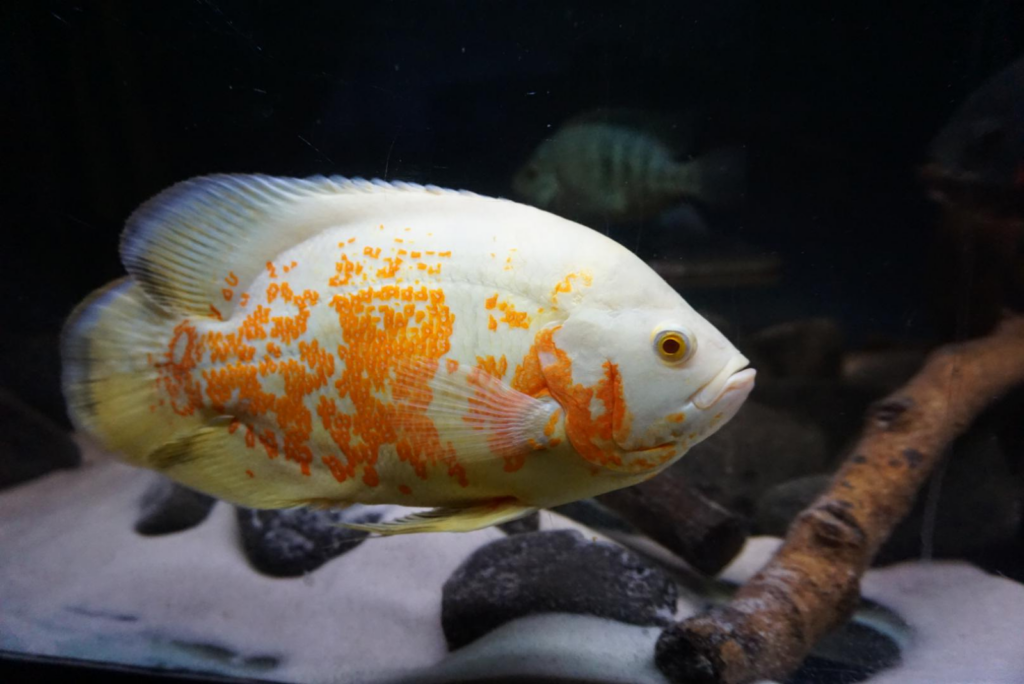Beautify your aquarium with one of these exciting varieties of Oscar fish. Get Care tips and learn unique identifying features at a glance. This guide is your ultimate answer to everything you need to know about these 13 fascinating types of Oscar Fish.

The unique Oscar fish is a species from the Cichlid family popular in South American waters. There are diverse Oscar fish types that you can keep as pets. Here’s the list of 13 Oscar fish and their care requirements:
Author’s Note: If you want to watch this article instead of reading it? Checkout the video below from our YouTube Channel, be sure to Subscribe For More Great Fishkeeping Content:
Tiger Oscar

This vibrant Oscar fish is known for its orange-red and black stripes, similar to a tiger’s skin, hence its name. It’s a popular Oscar variety and is one of the favored types you’ll find during research.
The Marble Oscar is another term occasionally used as an alternative name for the Tiger Oscar or Velvet Cichlid. This name highlights its marbled or mottled patterns, which resemble the unique and irregular color markings of the Tiger Oscar.
Care Tips
Tiger Oscar fish care is simple since they feed on high-quality flakes, pellets, and live or frozen food like shrimps and crickets. Add sand to your tank’s substrate so they have something to excavate when they get restless.
Albino Oscar

The Albino Oscar fish earned its name because of its unique appearance, which lacks melanin. It’s a pale yellow or sometimes white fish with bright orange, pink or red eyes. Despite its scales’ tone, this Oscar variation isn’t the same as the White Oscar fish. You’ll see that one in a bit.
Care Tips
Regular Oscar fish care, like maintaining lukewarm water at 74 – 81℉ and 6.5 – 7.5 pH, is good for the Albino species. Because of their sensitive eyes, an additional fish care tip is to use low lighting and keep them in stress-free tanks.
Red Oscar

Unlike the tiger stripes Oscar fish, the Red Oscar fish has mostly reddish scales with orange patches. It’s sometimes called the Red Chilli Oscar because of its bright scale color.
Care Tips
Normal tank conditions for Oscars, including water parameters 74 – 81℉ and 6.5 – 7.5 pH, work for this species.
This striking redfish has an aggressive temperament and a large appetite. It’ll eat anything that can enter its mouth, but feed it with high carotenoids to keep its reddish scales bright. Avoid pairing this species with smaller and calmer fish.
Lemon Oscar

Lemon Oscar fish has bright yellow and white scales like the fruit it’s named after. Sometimes, its bright yellow color covers the whole body while its fin edges have white tones, and other times, it’s a mix of both colors.
Unlike other Oscar fish varieties, the Lemon Oscar fish has a calm temperament. So, how can you care for this bright yellow Oscar fish?
Care Tips
Add veggies and protein to your Lemon Oscar fish diet and maintain a water temperature of 78 – 82℉. When testing this Oscar fish’s compatibility with others, remember its unique features. Keep it safe from fin-nipping varieties and other aggressive Oscars because they’re the milder of the bunch.
Lutino Oscar

Some people mistake the Lutino Oscar fish for the Albino Oscar because they have similar scale colors. But here’s the difference. Lutinos are pale yellow Oscar fish with orange and black marks on their fins’ edges. Also, they have orange or red but not pink like the Albino.
Care Tips
Lutino Oscar fish share the same fish care requirements as the Albino variety because of their similar features. But additionally, they need less food to prevent obesity and large tanks for exciting swimming.
This species suffers from common fish health issues, such as Swim bladder disease, Constipation, Obesity, and Scale Sensitivity.
Black Oscar

Most Black Oscar fish have pure black bodies, but some rare species have orange patches. Whether a solid black fish or a patterned species, the Black Oscar requires unique fish care.
Care Tips
Because of the Black Oscar fish’s temperament, I recommend keeping them away from passive fish. They become very aggressive during breeding and love to mark their territory.
Blue Oscar

If you want a beautiful pet in your aquarium, then add the Blue Oscar fish. It has a striking electric blue tone that’s sometimes mixed with black or gray spots. This bluish Oscar fish is the star in any aquarium and can live up to 10 – 20 years in the right conditions.
Care Tips
The ideal fish tank conditions for this bluish Oscar are 74 – 81℉ water temperature, soft substrate, and large tanks that hold up to 75 gallons of water. As for fish compatibility, this species can be tank mates with other fish that can handle their aggression.
Veil Tail Oscar

Have you ever seen a long-finned Oscar fish? Then, you’ve seen the Veil Tail Oscar fish with longer finnage than the other types in this family. Its tail is still wide and thick like a typical Oscar but longer than usual.
Also note that any Oscar fish can have a Veil Tail, whether it’s an Albino, Tiger, or even a Black Oscar.
Care Tips
This beautiful Oscar fish requires special fish care because of its different yet unique features. Keep it in a large tank to accommodate its long fins, and use soft substrate and decor to prevent injury.
Copper Oscar

The Copper Oscar fish is popular as an aquarium fish because of its striking scale patterns. It’s a metallic fish with a shiny copper tone that sometimes looks bronze. If you want to add this popular fish variety to your community tank, you must care for its unique Oscar features.
Care Tips
This metallic fish is adaptable and hardy but very sensitive to poor water quality. Create nice hiding spots in the tank for it to interact with and avoid overfeeding if you don’t want to risk fish illnesses.
Green Oscar

Because the Green Oscar fish is typically olive or has an earthy dark tone, it sometimes looks gray. But this greenish Oscar stands out in bright waters and sometimes has other patterns and marks like black stripes.
Care Tips
Green Oscar fish don’t have special fish care needs. They’re omnivorous and eat all kinds of food, including insects and smaller fish. Consider this feeding habit when testing for the Green Oscar fish compatibility with other species.
Don’t keep them with smaller and weaker fish to prevent predatory behavior.
White Oscar

The White Oscar fish has mostly white scale patterns, but it’s not always a pure white Oscar. It could have faint orange marks like the Albino Tiger Oscar or be plain white like the Albino Snow White Oscar. Also, it sometimes comes with black or gray accents, however invisible.
This distinctive fish look isn’t the only reason to add the White Oscar to your aquarium. Think of its unique low-maintenance care tips and not its aggressive temperament.
Care Tips
Keep White Oscar fish away from fin-nipping tank mates, and ensure you change their aquarium water bi-weekly or weekly, depending on the size.
Wild Oscar

Wild Oscar fish originated from the Amazon River basin and have wild fish characteristics, unlike other domesticated Oscar fish species. Because of their different features, they’re not popular aquarium fish.
Unlike other brightly colored varieties that stand out in any tank, the natural habitat for this Oscar fish has dull tones like pure gray, brown, and black.
Care Tips
The difference between domesticated vs Wild Oscar fish is their natural habitat, which affects every aspect of their lives. Wild Oscars are very active and need large tanks to move. Their aquariums need to mimic their natural home, including heavy branches and vegetation.
Platinum Oscar

This silvery-white Oscar is a rare fish type that’s sure to make an impact in any aquarium! The Platinum Oscar fish has a metallic color with unique marks matching its silvery-white tone and giving it a monochrome finish.
Add this type of Oscar fish to your tank to give it an exotic creme de la creme look.
Care Tips
This species has the same care requirements as other popular varieties, including the water parameters, tank size, and tank mates.
And that’s a wrap on the Oscar fish care requirements for the top 15 varieties to build your community tank. As a fellow aquarium enthusiast, I’ll leave you with some facts and advice.
Conclusion
Oscar fish, like Cichlids, aren’t the best tank mates for mild-mannered species because of their aggression. They only thrive with equally competitive and similar-sized fish like them.
As a beginner, I don’t advise keeping this type of fish in your tank. Instead, leave it for experienced aquarium enthusiasts. But if you must add this species to your community, take advantage of this list of diverse Oscar fish varieties and choose the most suitable one.
Also, pay attention to the fish care tips I’ve shared for each type so that you can match them to the ideal tank mate.












7 thoughts on “Explore 13 Fascinating Types of Oscar Fish: Care, Identification, and More ”